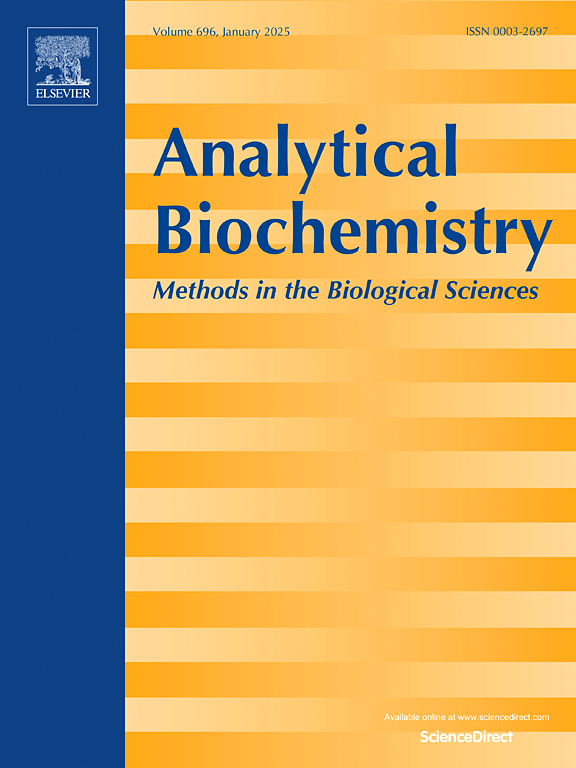Ammonium bicarbonate buffer system for DNA hybridization and quantification by LC-ESI-MS/MS
IF 2.5
4区 生物学
Q2 BIOCHEMICAL RESEARCH METHODS
引用次数: 0
Abstract
High salt buffer may be used for the UV/VIS or radiometric based detection of trihybrid DNA but would contaminate the electrospray mass spectrometer. Colorimetric DNA hybridization assays with the substrate BCIP/NBT reacted with the alkaline phosphatase-streptavidin (APSA) enzyme conjugate that showed a linear range for HIV DNA from 1 pM to 100 pM DNA in presence of high salt concentrations. Ammonia bicarbonate (AMBIC) or ethanolamine resulted in strong DNA hybridization similar to NaCl but was compatible with specific and sensitive mass spectrometry. Linear and Gaussian analysis of HIV DNA with 10 % error was achieved across the pico Molar range from APSA amplification that converted the substrate AMP to adenosine for detection by monitoring the precursor ion at m/z 268 and plotting the fragment intensity at m/z 136 (m/z 268→ m/z 136) that was linear to 100 fM after log transformation. The novel observation that specific DNA hybridization in NaCl may be substituted with AMBIC permitted the direct analysis of a target DNA in femto molar to pico molar range by enzyme linked mass spectrometric assay (ELiMSA) using as little as 0.1 μL (100 nL) of sample reaction injected on column.

碳酸氢铵缓冲系统用于DNA杂交和LC-ESI-MS/MS定量。
高盐缓冲液可用于基于紫外线/可见光或辐射计的三杂交 DNA 检测,但会污染电喷雾质谱仪。用碱性磷酸酶-链霉亲和素(APSA)酶结合物与底物 BCIP/NBT 进行比色 DNA 杂交检测,在高浓度盐存在下,HIV DNA 的线性范围为 1 pM 至 100 pM DNA。碳酸氢氨(AMBIC)或乙醇胺会导致与 NaCl 相似的强 DNA 杂交,但与特异性和灵敏的质谱分析兼容。通过监测 268 m/z 处的前体离子并绘制 m/z 136 处的片段强度图(m/z 268→ m/z 136),将底物 AMP 转化为腺苷进行检测的 APSA 扩增法实现了对 HIV DNA 的线性和高斯分析,误差在 10%的微摩尔范围内。由于新发现 NaCl 中的特异性 DNA 杂交可以用 AMBIC 替代,因此只需在色谱柱上注入 0.1 微升(100 nL)的样品反应,就可以通过酶联质谱分析法(ELiMSA)直接分析飞摩尔到皮摩尔范围内的目标 DNA。
本文章由计算机程序翻译,如有差异,请以英文原文为准。
求助全文
约1分钟内获得全文
求助全文
来源期刊

Analytical biochemistry
生物-分析化学
CiteScore
5.70
自引率
0.00%
发文量
283
审稿时长
44 days
期刊介绍:
The journal''s title Analytical Biochemistry: Methods in the Biological Sciences declares its broad scope: methods for the basic biological sciences that include biochemistry, molecular genetics, cell biology, proteomics, immunology, bioinformatics and wherever the frontiers of research take the field.
The emphasis is on methods from the strictly analytical to the more preparative that would include novel approaches to protein purification as well as improvements in cell and organ culture. The actual techniques are equally inclusive ranging from aptamers to zymology.
The journal has been particularly active in:
-Analytical techniques for biological molecules-
Aptamer selection and utilization-
Biosensors-
Chromatography-
Cloning, sequencing and mutagenesis-
Electrochemical methods-
Electrophoresis-
Enzyme characterization methods-
Immunological approaches-
Mass spectrometry of proteins and nucleic acids-
Metabolomics-
Nano level techniques-
Optical spectroscopy in all its forms.
The journal is reluctant to include most drug and strictly clinical studies as there are more suitable publication platforms for these types of papers.
 求助内容:
求助内容: 应助结果提醒方式:
应助结果提醒方式:


